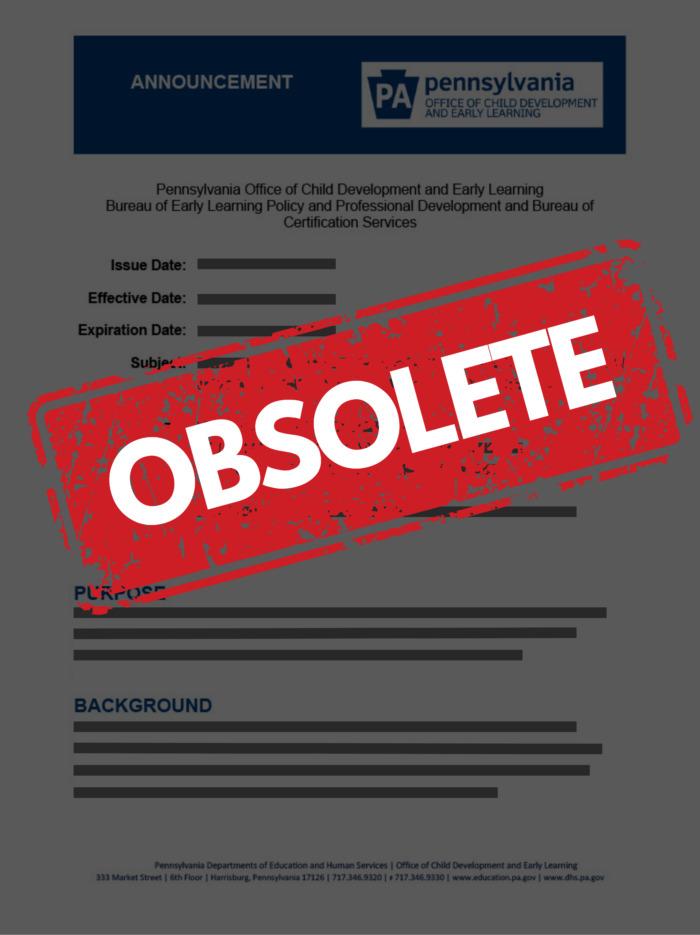 Created in 2007 by the Pennsylvania Office of Child Development and Early Learning (OCDEL), The Pennsylvania Key implements the work and supports the policies developed and managed by OCDEL. Learn More. >
Created in 2007 by the Pennsylvania Office of Child Development and Early Learning (OCDEL), The Pennsylvania Key implements the work and supports the policies developed and managed by OCDEL. Learn More. > Created in 2007 by the Pennsylvania Office of Child Development and Early Learning (OCDEL), The Pennsylvania Key implements the work and supports the policies developed and managed by OCDEL. Learn More. >
Created in 2007 by the Pennsylvania Office of Child Development and Early Learning (OCDEL), The Pennsylvania Key implements the work and supports the policies developed and managed by OCDEL. Learn More. >To:
From:
Tracey Campanini,
Deputy Secretary, Office of Child Development & Early Learning
Issue Date: June 23, 2020
Revised Date: July 8, 2020
Effective Date: Immediately
End Date: Sept. 29, 2020
To provide certified child care facilities with interim guidance for operating a facility during the Novel Coronavirus (COVID-19) pandemic. This guidance covers policies and procedures providers should implement during the COVID-19 pandemic. It also provides certified child care facilities with guidance on how to handle a positive COVID-19 case or exposure to a positive COVID-19 case in child care facilities. This revised version of C-20-06 includes updated information related to face coverings and corrections to text in the original announcement. These updates and corrections are provided in red text below.
Following the Proclamation of Disaster Emergency issued on March 6, 2020 by Governor Tom Wolf, statewide mitigation efforts were put in place to slow the spread of COVID-19. As Pennsylvania has transitioned into a phased reopening of the state, the Office of Child Development and Early Learning (OCDEL) acknowledges the need for guidance on operating a facility during the COVID-19 pandemic.
Child care facilities that continue to remain open or that are preparing to reopen should follow the guidance issued by the Centers for Disease Control and Prevention (CDC) and the Pennsylvania Department of Health (DOH). The guidance details the steps providers are recommended to follow in order to mitigate the impact of COVID-19 on child care facilities. OCDEL developed this guidance based on recommendations from the CDC and DOH and it is subject to change. Health and safety guidance for child care facilities during COVID-19 is outlined in this document. Please visit DOH and CDC for the most up to date information on COVID-19.
Topics addressed in this guidance include:
Child care providers should understand the aspects of reopening or continuing to operate during COVID-
Additional policies and procedures are strongly recommended to be put in place to protect the health and safety of children in care while maintaining a safe environment for child care employees and families. The CDC has developed a decision tool to assist in operating and reopening decisions during these unique circumstances. Child care providers should review and plan for the implementation of the CDC and DOH guidelines before reopening. It is suggested that child care providers develop and publicly post their implementation strategies to mitigate the further spread of COVID-19 and to inform parents of new procedures and expectations.
COVID-19 is mostly spread by respiratory droplets released when people talk, cough, or sneeze. It is thought that the virus may spread to hands from a contaminated surface and then to the nose or mouth, causing infection. Therefore, prevention practices and environmental cleaning and disinfection are important principles that are covered below.
People with COVID-19 have had a wide range of symptoms reported – ranging from mild symptoms to severe illness. Symptoms may appear 2-14 days after exposure to the virus. People with these symptoms may have COVID-19:
All guidance below is strongly recommended in order to adhere to guidelines published by the CDC and DOH.
Drop-off/Arrival Procedures
Child care programs are strongly recommended to:
Post signage in drop-off/arrival area to remind staff and children to keep six feet of distance whenever feasible.
Screening Procedures:
The best way to prevent the spread of COVID-19 is to prevent it from getting inside the facility. Child care providers should:
Persons who have a fever of 100.4 degrees Fahrenheit or above, or other signs of illness should not be admitted to the facility. Encourage parents to be on the alert for signs of illness in their children and to keep them home when they are sick.
Routine disinfecting/sanitization procedures:
Child care facilities should post signs in highly visible locations (e.g., facility doors, lobby, restrooms) that promote everyday protective measures and describe how to stop the spread of COVID-19 such as by properly washing hands and properly wearing a cloth face covering.
Resources for signage for handwashing can be found here. Signage for face coverings can be found here.
Caring for Our Children (CFOC) provides national standards for cleaning, sanitizing and disinfection of educational facilities for children. Toys that can be put in the mouth should be cleaned and sanitized (see below). Other hard surfaces, including diaper changing stations, doorknobs, and floors can be disinfected.
Intensify cleaning and disinfection efforts:
Clean and Sanitize Toys:
Clean and Disinfect Bedding:
If possible, child care classes should include the same group each day, and the same child care providers should remain with the same group each day. If your child care program remains open, consider creating a separate classroom or group for the children of healthcare workers and other first responders. Cancel or postpone special events such as festivals, holiday events, and special performances.
Child care staff are required to wear cloth face coverings. Children 2 years old and older are required to wear a face covering as described in the Order of the Secretary of the Pennsylvania Department of Health Order for Universal Face Coverings, unless you fit one of the exceptions included in Section 3 of the Order.
If a child is outdoors and able to consistently maintain a social distance of at least 6 feet from individuals who are not a part of their household, they do not need to wear a mask.
If a parent, guardian, or responsible person has been unable to place a face covering safely on the child’s face, they should not do so.
If a child 2 years old or older is unable to remove a face covering without assistance, the child is not required to wear one.
The Department of Health recognizes that getting younger children to be comfortable wearing face coverings and to keep them on may create some difficulties. Under these circumstances, parents, guardians, licensed child care providers in community-based and school settings or responsible persons may consider prioritizing the wearing of face coverings to times when it is difficult for the child to maintain a social distance of at least 6 feet from others who are not a part of their household (e.g., during carpool drop off or pick up, or when standing in line at school). Ensuring proper face covering size and fit and providing children with frequent reminders and education on the importance and proper wearing of cloth face coverings may help address these issues.
The following pertains to all child care staff, household members residing in a group child care home or family child care home, and children at a child care facility.
For confirmed positive COVID 19-cases:
*An outbreak is defined as a single positive COVID-19 case.
Exposure to a person who tests positive for COVID-19:
Exposure is defined as being within 6 feet of the individual who tests positive for COVID-19 for a period of 15 minutes or more. It also means coming into direct contact with droplets from a COVID-19 positive individual. Persons who test positive are considered infectious 48 hours before the onset of symptoms. Persons testing positive but do not have symptoms are considered infectious 2 days after exposure (if known) or starting 2 days before test date (if exposure is unknown).
If a staff person, household member, or a child is exposed to an individual who tests positive for COVID- 19:
Discontinuing at home isolation:
There are different strategies for discontinuing home isolation. Options include a symptom based (i.e., time-since-illness-onset and time-since-recovery strategy) or test based strategy. Child care providers should utilize the strategy that is best for their facility and that maintains the health and safety of children in care.
1). Symptom-Based Strategy
Individuals with COVID-19 who have symptoms and were directed to care for themselves at home may discontinue isolation under the following conditions:
2). Test-Based Strategy
Individuals who have COVID-19 who have symptoms and were directed to care for themselves at home may discontinue isolation under the following conditions:
For Persons Who Tested Positive but have NOT had COVID-19 Symptoms in Home Isolation:
Persons with laboratory-confirmed COVID-19 who have not had any symptoms and were directed to care for themselves at home may discontinue isolation under the following conditions:
If they develop symptoms, then the symptom-based or test-based strategy should be used.
Persons with laboratory-confirmed COVID-19 who have not had any symptoms and were directed to care for themselves at home may discontinue isolation under the following conditions:
The symptom-based, time-based, and test-based strategies may result in different timeframes for discontinuation of isolation post-recovery. Any individual who becomes ill should contact their medical provider for advice or testing. For any individual who has been exposed to COVID-19 as described above, or who tests positive for COVID-19, follow the information outlined above.
In all instances when reporting to DHS, please provide:
This information must immediately be reported to your Certification Representative or the appropriate Regional Office which can be found here.
For questions regarding COVID-19, isolation, and quarantine, please contact DOH at 1-877-PA-HEALTH.
To report confirmed positive cases of COVID-19, please contact DOH at 1-877-PA-HEALTH or 1-877- 724-3258.
If a child care provider is aware of a retailer selling personal protective equipment for well above the manufactures suggested retail price The Office of Attorney General handles these issues. Visit their website to file a complaint.
DHS provider resources: https://www.dhs.pa.gov/providers/Providers/Pages/Coronavirus-Provider- Resources.aspx
Pennsylvania Key resources on COVID-19 (coronavirus) in Pennsylvania for ECE programs and professionals: https://www.pakeys.org/ece-coronavirus-resources/
Department of Economic and Community Development – Pennsylvania COVID-19 PPE & Supplies Business-2-Business (B2B) Interchange Directory- to connect with Pennsylvania business selling supplies: https://dced.pa.gov/pa-covid-19-medical-supply-portals/pennsylvania-covid-19-ppe-supplies- business-2-business-b2b-interchange-directory/
Child care providers must:
Comments and Questions Regarding this Announcement Should be Directed to the Provider’s Regional Office of Child Development and Early Learning: Central Region 800-222-2117; Northeast Region 800-222-2108; Southeast North and Southeast South Region 800-346-2929; Western Region 800-222-2149.
